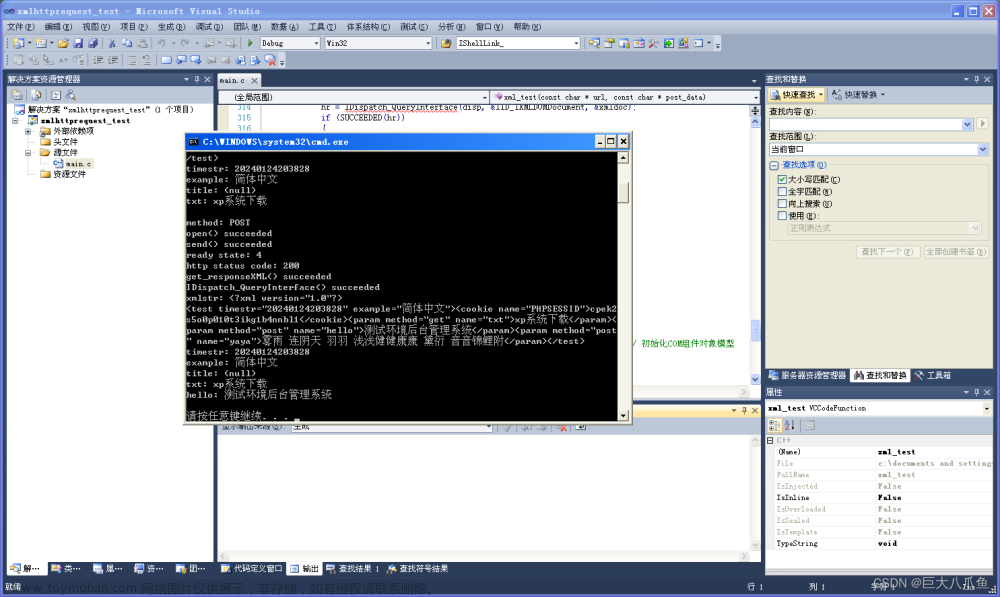HTTP POST请求传参方式
方式一:
String url = "http://xxxxxxx";
logger.info("访问接口url: " + url);
Map<String, String> paramsMap = new HashMap<>();
paramsMap.put("name", "小明");
paramsMap.put("age", 18);
String paramJson = JSON.toJSONString(paramsMap);
logger.info("json传参:" + paramJson);
HttpHeaders headers = new HttpHeaders();
headers.set("X-Access-token", token);
logger.info("设置token:" + token);
headers.setAccept(Collections.singletonList(MediaType.APPLICATION_JSON));
logger.info("设置请求Accept格式:APPLICATION_JSON");
headers.setContentType(MediaType.APPLICATION_JSON);
logger.info("设置请求ContentType格式:APPLICATION_JSON");
HttpEntity<String> request = new HttpEntity<String>(paramJson, headers);
try {
restTemplate.getMessageConverters().set(1, new StringHttpMessageConverter(StandardCharsets.UTF_8));
response = restTemplate.postForEntity(url, request, Map.class);
map = (Map<String, Object>) response.getBody();
logger.info("获取请求接口返回信息:" + map);
Map<String, Object> map_data = (Map<String, Object>) map.get("data");
方式二文章来源:https://www.toymoban.com/news/detail-618280.html
// 创建HttpClient对象
CloseableHttpClient httpclient = HttpClients.createDefault();
//http请求url
HttpPost httpPost = new HttpPost("http://xxxx");
// 模拟POST/PUT的body中数据,需转为JSON进行签名.
Map<String, Object> dataMap = new HashMap<String, Object>();
//POST请求参数
//授权码
dataMap.put("authorizationKey", "");
//客户端IP
dataMap.put("clientIp", "");
//名称
dataMap.put("name", "");
//转为json传参
String bodyParam = new Gson().toJson(dataMap);
//设置编码
StringEntity bodyData = new StringEntity(bodyParam, "UTF-8");
httpPost.setEntity(bodyData);
try {
httpPost.setHeader("Content-type", "application/json");
httpPost.setHeader("User-Agent", "Mozilla/4.0 (compatible; MSIE 5.0; Windows NT; DigExt)");
String urlStr = httpPost.getURI().toString();
// 公共参数URL
httpPost.setURI(new URI(urlStr));
//请求超时时间
RequestConfig requestConfig = RequestConfig.custom().setConnectTimeout(5000)
.setConnectionRequestTimeout(5000).setSocketTimeout(5000).build();
httpPost.setConfig(requestConfig);
// 执行请求
CloseableHttpResponse response = httpclient.execute(httpPost);
// 取响应的结果
int statusCode = response.getStatusLine().getStatusCode();
if (statusCode == HttpStatus.SC_OK) {
String resp = EntityUtils.toString(response.getEntity());
//此处不同格式的返回信息 用不通方式的json去转
//请看 https://blog.csdn.net/weixin_38193704/article/details/127402069?spm=1001.2014.3001.5502
JSONArray jsonArray = (JSONArray) JSONArray.parse(resp);
if (ObjectUtils.isNotEmpty(jsonArray)) {
JSONObject objectJson = jsonArray.getJSONObject(0);
System.out.println("获取返回值json信息" + objectJson);
}
}
} catch (Exception e1) {
e1.printStackTrace();
}
HTTP GET请求传参方式文章来源地址https://www.toymoban.com/news/detail-618280.html
//请求参数
String getQueryParam = "USER_ID=" + userId + "&" + "USER_NO=" + userNo + "&" + "IDCARD_NO=" + idcardNo;
// 时间戳
Long ts = Calendar.getInstance().getTime().getTime();
// 随机数
String once = RandomStringUtils.randomAlphanumeric(RANDOM_UUID);
//签名算法
String signMethod = "SHA-256";
// 接口header中的公共参数
String commonParamUrl = String.format("appKey=%s" + "&" + "ts=%s" + "&" + "once=%s" + "&" + "signMethod=%s",
geerappkey.get(0).getFieldValue(), ts, once, signMethod);
// 创建HttpClient对象
CloseableHttpClient httpclient = HttpClients.createDefault();
//请求的url
String getFullUrl = serverApiUrl + "?" + queryParam;
HttpGet httpGet = new HttpGet(getFullUrl);
//路径添加header信息
String getAllParamUrl = commonParamUrl + "&" + queryParam;
try {
//获取签名数据
String signData = TokenUtil.getSignature(geerpwd.get(0).getFieldValue(), getAllParamUrl, signMethod);
log.info("获取请求机构信息签名===" + signData);
// 添加header参数 appCode、timestamp、 signaturenonce、signature
httpGet.addHeader("appKey", geerappkey.get(0).getFieldValue());
httpGet.addHeader("ts", ts.toString());
httpGet.addHeader("once", once);
httpGet.addHeader("signMethod", signMethod);
httpGet.addHeader("signData", signData);
String urlStr = httpGet.getURI().toString();
// 公共参数URL
log.info("get commonParamter:" + urlStr);
if (StringUtils.endsWith(urlStr, "/")) {
urlStr = StringUtils.removeEnd(urlStr, "/");
}
//请求时间设置
httpGet.setURI(new URI(urlStr));
RequestConfig requestConfig = RequestConfig.custom().setConnectTimeout(3000)
.setConnectionRequestTimeout(3000).setSocketTimeout(3000).build();
httpGet.setConfig(requestConfig);
log.info("urlStr in request:" + httpGet.getURI().toString());
// 执行请求
CloseableHttpResponse response = httpclient.execute(httpGet);
// 取响应的结果
int statusCode = response.getStatusLine().getStatusCode();
log.info("response code status:" + statusCode);
// 打印响应结果
if (statusCode == HttpStatus.SC_OK) {
String result = EntityUtils.toString(response.getEntity(), "utf-8");
JSONObject resultJson = JSON.parseObject(result);
log.info("checkIdentityParam body:" + resultJson);
return resultJson;
}
} catch (URISyntaxException e) {
//签名失败
e.printStackTrace();
} catch (ClientProtocolException e) {
e.printStackTrace();
} catch (IOException e) {
e.printStackTrace();
} catch (Exception e) {
e.printStackTrace();
}
到了这里,关于Java http GET POST 请求传参的文章就介绍完了。如果您还想了解更多内容,请在右上角搜索TOY模板网以前的文章或继续浏览下面的相关文章,希望大家以后多多支持TOY模板网!









